Leadership Essay: Analyzing Covey's 7 Habits for Effective Leadership
VerifiedAdded on 2021/06/15
|9
|2747
|25
Essay
AI Summary
This essay provides a detailed analysis of Stephen Covey's 'The 7 Habits of Highly Effective People,' focusing on its relevance to leadership and workplace effectiveness. It explores Covey's principles, including the P/PC ratio, character ethics, and the progression from dependence to interdependence. The essay examines each of the seven habits, such as being proactive, beginning with the end in mind, putting first things first, thinking win-win, seeking first to understand, and synergizing, and sharpening the saw. The author reflects on the book's impact on their own professional life, highlighting the importance of abundance mentality, self-improvement, and balancing personal and professional life. The essay concludes by emphasizing the practical value of Covey's principles for business leaders and employees seeking to enhance their skills and achieve success.
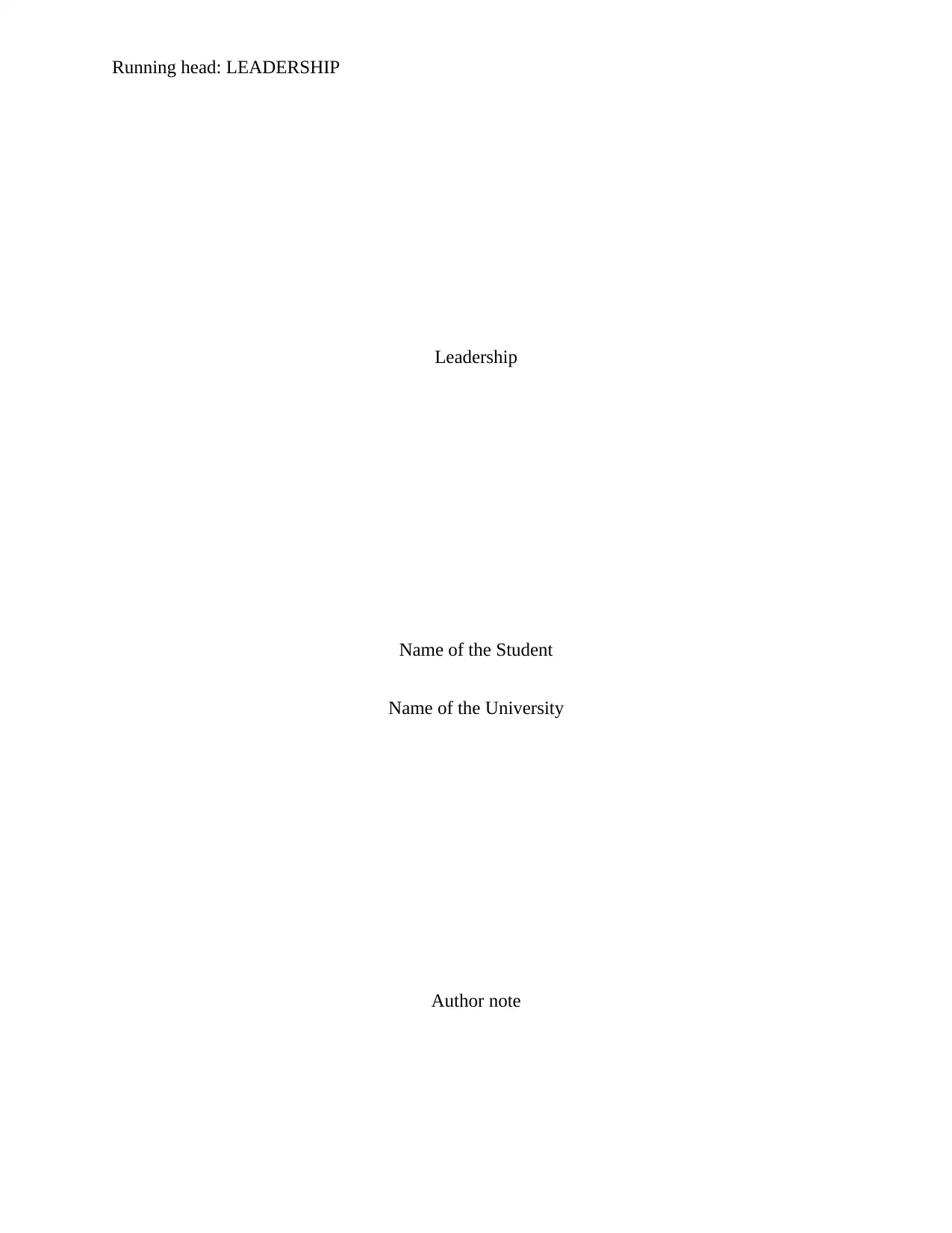
Running head: LEADERSHIP
Leadership
Name of the Student
Name of the University
Author note
Leadership
Name of the Student
Name of the University
Author note
Paraphrase This Document
Need a fresh take? Get an instant paraphrase of this document with our AI Paraphraser
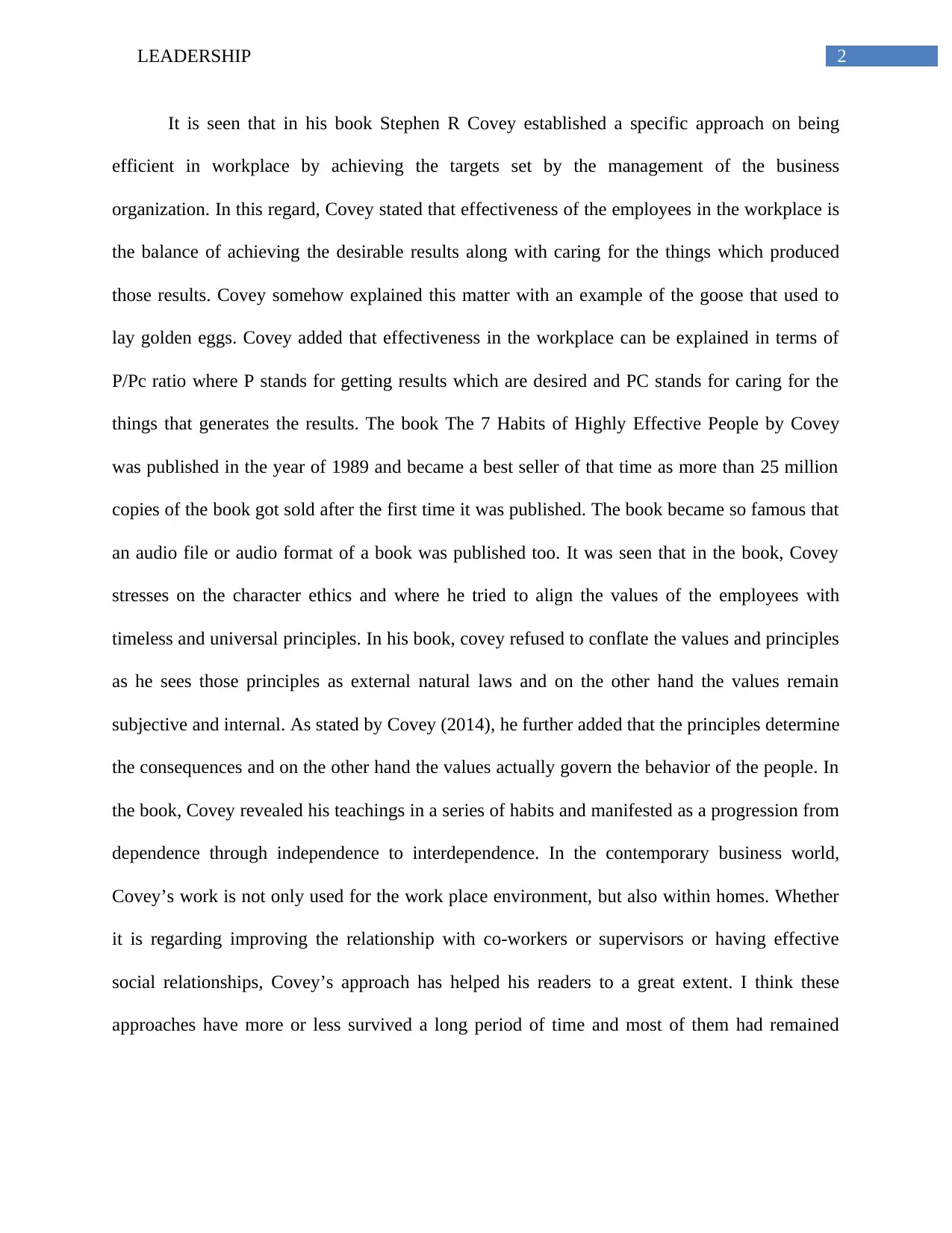
2LEADERSHIP
It is seen that in his book Stephen R Covey established a specific approach on being
efficient in workplace by achieving the targets set by the management of the business
organization. In this regard, Covey stated that effectiveness of the employees in the workplace is
the balance of achieving the desirable results along with caring for the things which produced
those results. Covey somehow explained this matter with an example of the goose that used to
lay golden eggs. Covey added that effectiveness in the workplace can be explained in terms of
P/Pc ratio where P stands for getting results which are desired and PC stands for caring for the
things that generates the results. The book The 7 Habits of Highly Effective People by Covey
was published in the year of 1989 and became a best seller of that time as more than 25 million
copies of the book got sold after the first time it was published. The book became so famous that
an audio file or audio format of a book was published too. It was seen that in the book, Covey
stresses on the character ethics and where he tried to align the values of the employees with
timeless and universal principles. In his book, covey refused to conflate the values and principles
as he sees those principles as external natural laws and on the other hand the values remain
subjective and internal. As stated by Covey (2014), he further added that the principles determine
the consequences and on the other hand the values actually govern the behavior of the people. In
the book, Covey revealed his teachings in a series of habits and manifested as a progression from
dependence through independence to interdependence. In the contemporary business world,
Covey’s work is not only used for the work place environment, but also within homes. Whether
it is regarding improving the relationship with co-workers or supervisors or having effective
social relationships, Covey’s approach has helped his readers to a great extent. I think these
approaches have more or less survived a long period of time and most of them had remained
It is seen that in his book Stephen R Covey established a specific approach on being
efficient in workplace by achieving the targets set by the management of the business
organization. In this regard, Covey stated that effectiveness of the employees in the workplace is
the balance of achieving the desirable results along with caring for the things which produced
those results. Covey somehow explained this matter with an example of the goose that used to
lay golden eggs. Covey added that effectiveness in the workplace can be explained in terms of
P/Pc ratio where P stands for getting results which are desired and PC stands for caring for the
things that generates the results. The book The 7 Habits of Highly Effective People by Covey
was published in the year of 1989 and became a best seller of that time as more than 25 million
copies of the book got sold after the first time it was published. The book became so famous that
an audio file or audio format of a book was published too. It was seen that in the book, Covey
stresses on the character ethics and where he tried to align the values of the employees with
timeless and universal principles. In his book, covey refused to conflate the values and principles
as he sees those principles as external natural laws and on the other hand the values remain
subjective and internal. As stated by Covey (2014), he further added that the principles determine
the consequences and on the other hand the values actually govern the behavior of the people. In
the book, Covey revealed his teachings in a series of habits and manifested as a progression from
dependence through independence to interdependence. In the contemporary business world,
Covey’s work is not only used for the work place environment, but also within homes. Whether
it is regarding improving the relationship with co-workers or supervisors or having effective
social relationships, Covey’s approach has helped his readers to a great extent. I think these
approaches have more or less survived a long period of time and most of them had remained
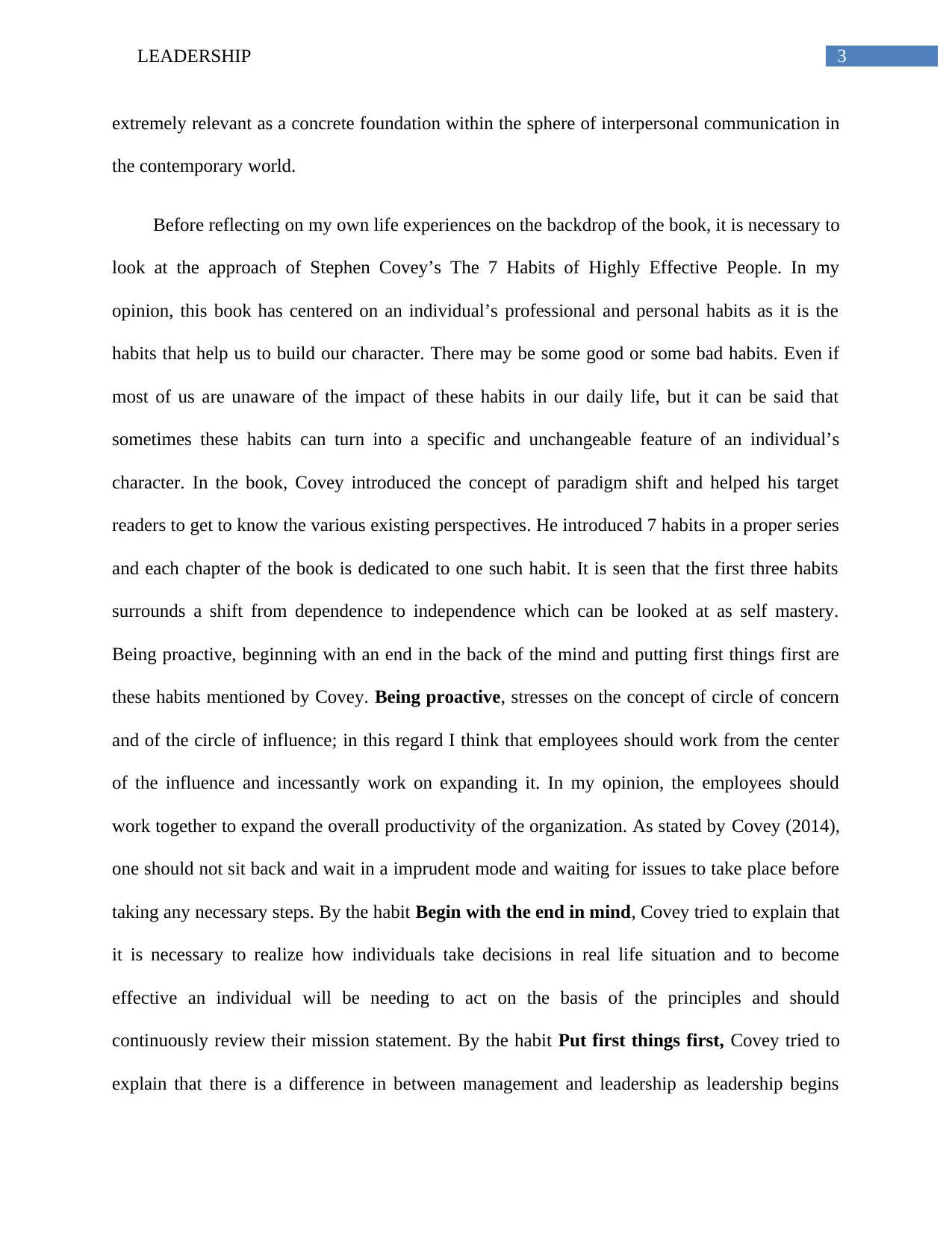
3LEADERSHIP
extremely relevant as a concrete foundation within the sphere of interpersonal communication in
the contemporary world.
Before reflecting on my own life experiences on the backdrop of the book, it is necessary to
look at the approach of Stephen Covey’s The 7 Habits of Highly Effective People. In my
opinion, this book has centered on an individual’s professional and personal habits as it is the
habits that help us to build our character. There may be some good or some bad habits. Even if
most of us are unaware of the impact of these habits in our daily life, but it can be said that
sometimes these habits can turn into a specific and unchangeable feature of an individual’s
character. In the book, Covey introduced the concept of paradigm shift and helped his target
readers to get to know the various existing perspectives. He introduced 7 habits in a proper series
and each chapter of the book is dedicated to one such habit. It is seen that the first three habits
surrounds a shift from dependence to independence which can be looked at as self mastery.
Being proactive, beginning with an end in the back of the mind and putting first things first are
these habits mentioned by Covey. Being proactive, stresses on the concept of circle of concern
and of the circle of influence; in this regard I think that employees should work from the center
of the influence and incessantly work on expanding it. In my opinion, the employees should
work together to expand the overall productivity of the organization. As stated by Covey (2014),
one should not sit back and wait in a imprudent mode and waiting for issues to take place before
taking any necessary steps. By the habit Begin with the end in mind, Covey tried to explain that
it is necessary to realize how individuals take decisions in real life situation and to become
effective an individual will be needing to act on the basis of the principles and should
continuously review their mission statement. By the habit Put first things first, Covey tried to
explain that there is a difference in between management and leadership as leadership begins
extremely relevant as a concrete foundation within the sphere of interpersonal communication in
the contemporary world.
Before reflecting on my own life experiences on the backdrop of the book, it is necessary to
look at the approach of Stephen Covey’s The 7 Habits of Highly Effective People. In my
opinion, this book has centered on an individual’s professional and personal habits as it is the
habits that help us to build our character. There may be some good or some bad habits. Even if
most of us are unaware of the impact of these habits in our daily life, but it can be said that
sometimes these habits can turn into a specific and unchangeable feature of an individual’s
character. In the book, Covey introduced the concept of paradigm shift and helped his target
readers to get to know the various existing perspectives. He introduced 7 habits in a proper series
and each chapter of the book is dedicated to one such habit. It is seen that the first three habits
surrounds a shift from dependence to independence which can be looked at as self mastery.
Being proactive, beginning with an end in the back of the mind and putting first things first are
these habits mentioned by Covey. Being proactive, stresses on the concept of circle of concern
and of the circle of influence; in this regard I think that employees should work from the center
of the influence and incessantly work on expanding it. In my opinion, the employees should
work together to expand the overall productivity of the organization. As stated by Covey (2014),
one should not sit back and wait in a imprudent mode and waiting for issues to take place before
taking any necessary steps. By the habit Begin with the end in mind, Covey tried to explain that
it is necessary to realize how individuals take decisions in real life situation and to become
effective an individual will be needing to act on the basis of the principles and should
continuously review their mission statement. By the habit Put first things first, Covey tried to
explain that there is a difference in between management and leadership as leadership begins
⊘ This is a preview!⊘
Do you want full access?
Subscribe today to unlock all pages.

Trusted by 1+ million students worldwide
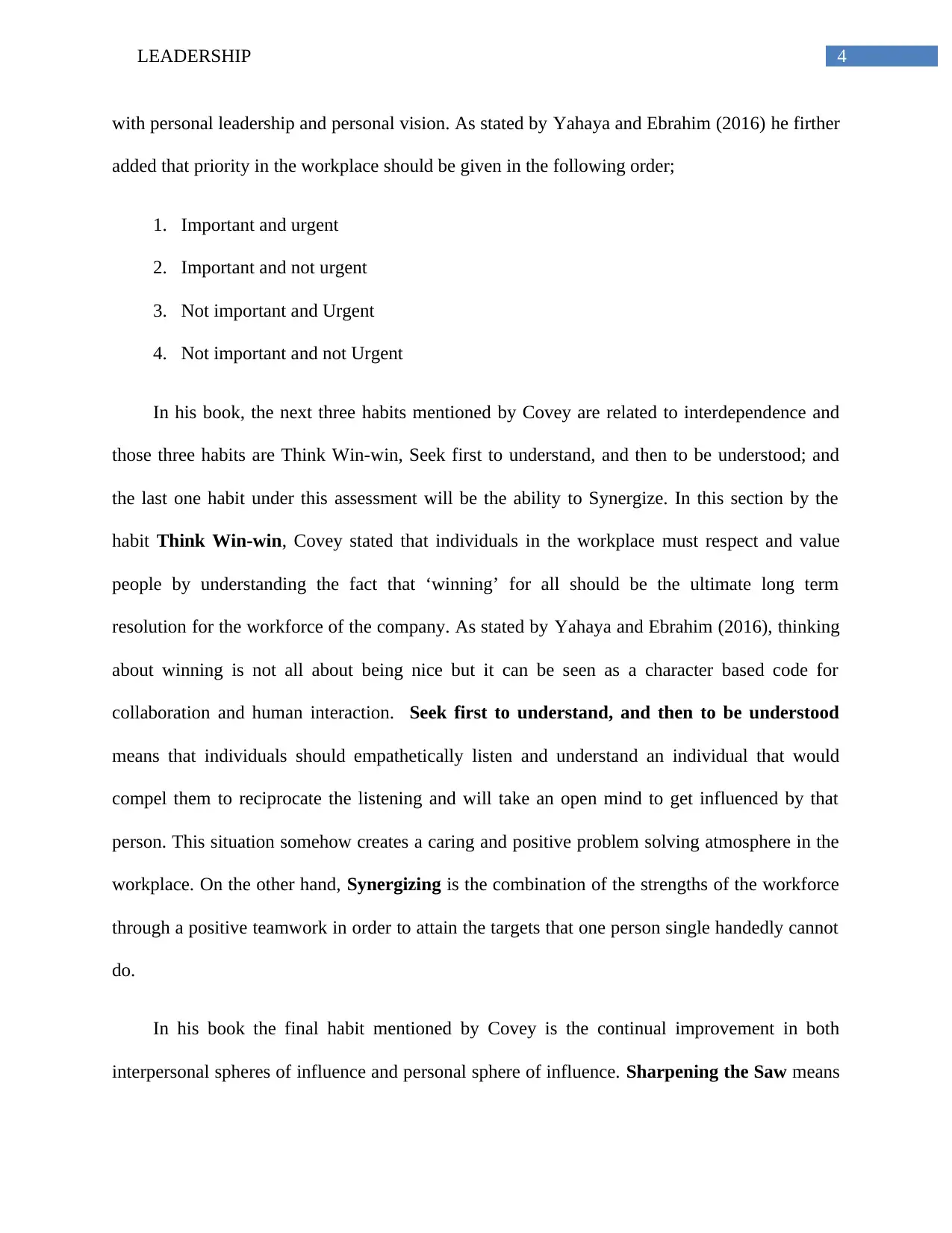
4LEADERSHIP
with personal leadership and personal vision. As stated by Yahaya and Ebrahim (2016) he firther
added that priority in the workplace should be given in the following order;
1. Important and urgent
2. Important and not urgent
3. Not important and Urgent
4. Not important and not Urgent
In his book, the next three habits mentioned by Covey are related to interdependence and
those three habits are Think Win-win, Seek first to understand, and then to be understood; and
the last one habit under this assessment will be the ability to Synergize. In this section by the
habit Think Win-win, Covey stated that individuals in the workplace must respect and value
people by understanding the fact that ‘winning’ for all should be the ultimate long term
resolution for the workforce of the company. As stated by Yahaya and Ebrahim (2016), thinking
about winning is not all about being nice but it can be seen as a character based code for
collaboration and human interaction. Seek first to understand, and then to be understood
means that individuals should empathetically listen and understand an individual that would
compel them to reciprocate the listening and will take an open mind to get influenced by that
person. This situation somehow creates a caring and positive problem solving atmosphere in the
workplace. On the other hand, Synergizing is the combination of the strengths of the workforce
through a positive teamwork in order to attain the targets that one person single handedly cannot
do.
In his book the final habit mentioned by Covey is the continual improvement in both
interpersonal spheres of influence and personal sphere of influence. Sharpening the Saw means
with personal leadership and personal vision. As stated by Yahaya and Ebrahim (2016) he firther
added that priority in the workplace should be given in the following order;
1. Important and urgent
2. Important and not urgent
3. Not important and Urgent
4. Not important and not Urgent
In his book, the next three habits mentioned by Covey are related to interdependence and
those three habits are Think Win-win, Seek first to understand, and then to be understood; and
the last one habit under this assessment will be the ability to Synergize. In this section by the
habit Think Win-win, Covey stated that individuals in the workplace must respect and value
people by understanding the fact that ‘winning’ for all should be the ultimate long term
resolution for the workforce of the company. As stated by Yahaya and Ebrahim (2016), thinking
about winning is not all about being nice but it can be seen as a character based code for
collaboration and human interaction. Seek first to understand, and then to be understood
means that individuals should empathetically listen and understand an individual that would
compel them to reciprocate the listening and will take an open mind to get influenced by that
person. This situation somehow creates a caring and positive problem solving atmosphere in the
workplace. On the other hand, Synergizing is the combination of the strengths of the workforce
through a positive teamwork in order to attain the targets that one person single handedly cannot
do.
In his book the final habit mentioned by Covey is the continual improvement in both
interpersonal spheres of influence and personal sphere of influence. Sharpening the Saw means
Paraphrase This Document
Need a fresh take? Get an instant paraphrase of this document with our AI Paraphraser
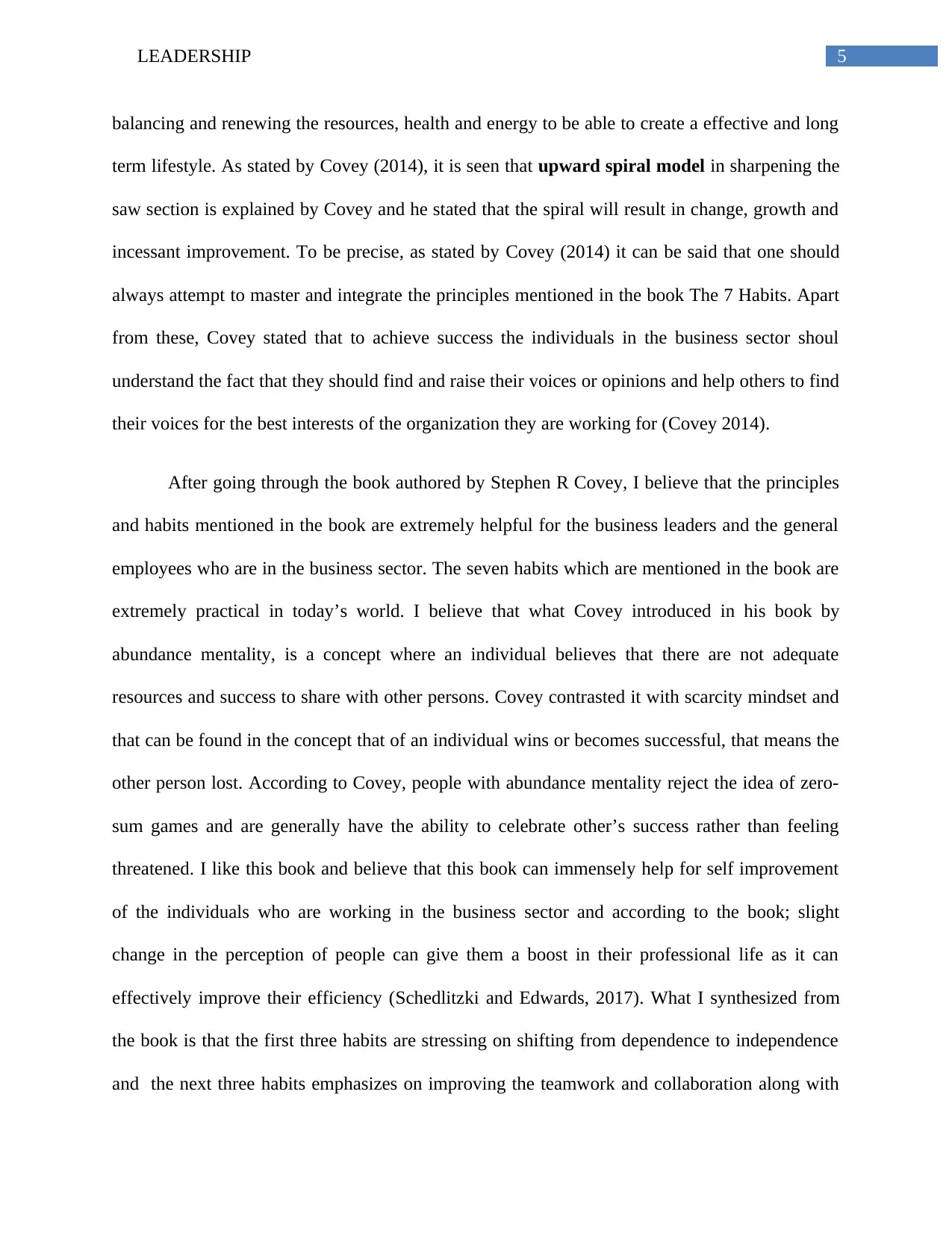
5LEADERSHIP
balancing and renewing the resources, health and energy to be able to create a effective and long
term lifestyle. As stated by Covey (2014), it is seen that upward spiral model in sharpening the
saw section is explained by Covey and he stated that the spiral will result in change, growth and
incessant improvement. To be precise, as stated by Covey (2014) it can be said that one should
always attempt to master and integrate the principles mentioned in the book The 7 Habits. Apart
from these, Covey stated that to achieve success the individuals in the business sector shoul
understand the fact that they should find and raise their voices or opinions and help others to find
their voices for the best interests of the organization they are working for (Covey 2014).
After going through the book authored by Stephen R Covey, I believe that the principles
and habits mentioned in the book are extremely helpful for the business leaders and the general
employees who are in the business sector. The seven habits which are mentioned in the book are
extremely practical in today’s world. I believe that what Covey introduced in his book by
abundance mentality, is a concept where an individual believes that there are not adequate
resources and success to share with other persons. Covey contrasted it with scarcity mindset and
that can be found in the concept that of an individual wins or becomes successful, that means the
other person lost. According to Covey, people with abundance mentality reject the idea of zero-
sum games and are generally have the ability to celebrate other’s success rather than feeling
threatened. I like this book and believe that this book can immensely help for self improvement
of the individuals who are working in the business sector and according to the book; slight
change in the perception of people can give them a boost in their professional life as it can
effectively improve their efficiency (Schedlitzki and Edwards, 2017). What I synthesized from
the book is that the first three habits are stressing on shifting from dependence to independence
and the next three habits emphasizes on improving the teamwork and collaboration along with
balancing and renewing the resources, health and energy to be able to create a effective and long
term lifestyle. As stated by Covey (2014), it is seen that upward spiral model in sharpening the
saw section is explained by Covey and he stated that the spiral will result in change, growth and
incessant improvement. To be precise, as stated by Covey (2014) it can be said that one should
always attempt to master and integrate the principles mentioned in the book The 7 Habits. Apart
from these, Covey stated that to achieve success the individuals in the business sector shoul
understand the fact that they should find and raise their voices or opinions and help others to find
their voices for the best interests of the organization they are working for (Covey 2014).
After going through the book authored by Stephen R Covey, I believe that the principles
and habits mentioned in the book are extremely helpful for the business leaders and the general
employees who are in the business sector. The seven habits which are mentioned in the book are
extremely practical in today’s world. I believe that what Covey introduced in his book by
abundance mentality, is a concept where an individual believes that there are not adequate
resources and success to share with other persons. Covey contrasted it with scarcity mindset and
that can be found in the concept that of an individual wins or becomes successful, that means the
other person lost. According to Covey, people with abundance mentality reject the idea of zero-
sum games and are generally have the ability to celebrate other’s success rather than feeling
threatened. I like this book and believe that this book can immensely help for self improvement
of the individuals who are working in the business sector and according to the book; slight
change in the perception of people can give them a boost in their professional life as it can
effectively improve their efficiency (Schedlitzki and Edwards, 2017). What I synthesized from
the book is that the first three habits are stressing on shifting from dependence to independence
and the next three habits emphasizes on improving the teamwork and collaboration along with
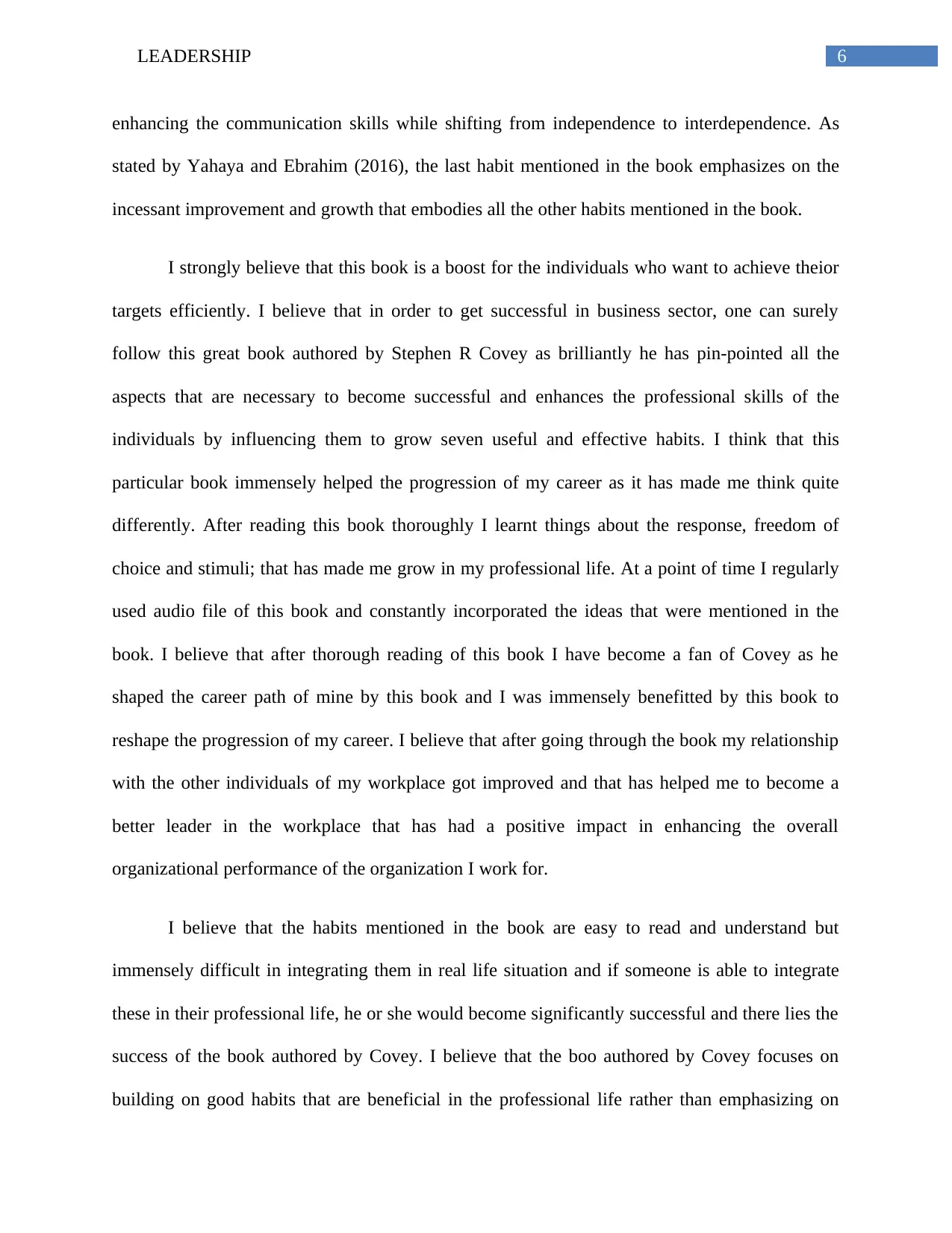
6LEADERSHIP
enhancing the communication skills while shifting from independence to interdependence. As
stated by Yahaya and Ebrahim (2016), the last habit mentioned in the book emphasizes on the
incessant improvement and growth that embodies all the other habits mentioned in the book.
I strongly believe that this book is a boost for the individuals who want to achieve theior
targets efficiently. I believe that in order to get successful in business sector, one can surely
follow this great book authored by Stephen R Covey as brilliantly he has pin-pointed all the
aspects that are necessary to become successful and enhances the professional skills of the
individuals by influencing them to grow seven useful and effective habits. I think that this
particular book immensely helped the progression of my career as it has made me think quite
differently. After reading this book thoroughly I learnt things about the response, freedom of
choice and stimuli; that has made me grow in my professional life. At a point of time I regularly
used audio file of this book and constantly incorporated the ideas that were mentioned in the
book. I believe that after thorough reading of this book I have become a fan of Covey as he
shaped the career path of mine by this book and I was immensely benefitted by this book to
reshape the progression of my career. I believe that after going through the book my relationship
with the other individuals of my workplace got improved and that has helped me to become a
better leader in the workplace that has had a positive impact in enhancing the overall
organizational performance of the organization I work for.
I believe that the habits mentioned in the book are easy to read and understand but
immensely difficult in integrating them in real life situation and if someone is able to integrate
these in their professional life, he or she would become significantly successful and there lies the
success of the book authored by Covey. I believe that the boo authored by Covey focuses on
building on good habits that are beneficial in the professional life rather than emphasizing on
enhancing the communication skills while shifting from independence to interdependence. As
stated by Yahaya and Ebrahim (2016), the last habit mentioned in the book emphasizes on the
incessant improvement and growth that embodies all the other habits mentioned in the book.
I strongly believe that this book is a boost for the individuals who want to achieve theior
targets efficiently. I believe that in order to get successful in business sector, one can surely
follow this great book authored by Stephen R Covey as brilliantly he has pin-pointed all the
aspects that are necessary to become successful and enhances the professional skills of the
individuals by influencing them to grow seven useful and effective habits. I think that this
particular book immensely helped the progression of my career as it has made me think quite
differently. After reading this book thoroughly I learnt things about the response, freedom of
choice and stimuli; that has made me grow in my professional life. At a point of time I regularly
used audio file of this book and constantly incorporated the ideas that were mentioned in the
book. I believe that after thorough reading of this book I have become a fan of Covey as he
shaped the career path of mine by this book and I was immensely benefitted by this book to
reshape the progression of my career. I believe that after going through the book my relationship
with the other individuals of my workplace got improved and that has helped me to become a
better leader in the workplace that has had a positive impact in enhancing the overall
organizational performance of the organization I work for.
I believe that the habits mentioned in the book are easy to read and understand but
immensely difficult in integrating them in real life situation and if someone is able to integrate
these in their professional life, he or she would become significantly successful and there lies the
success of the book authored by Covey. I believe that the boo authored by Covey focuses on
building on good habits that are beneficial in the professional life rather than emphasizing on
⊘ This is a preview!⊘
Do you want full access?
Subscribe today to unlock all pages.

Trusted by 1+ million students worldwide
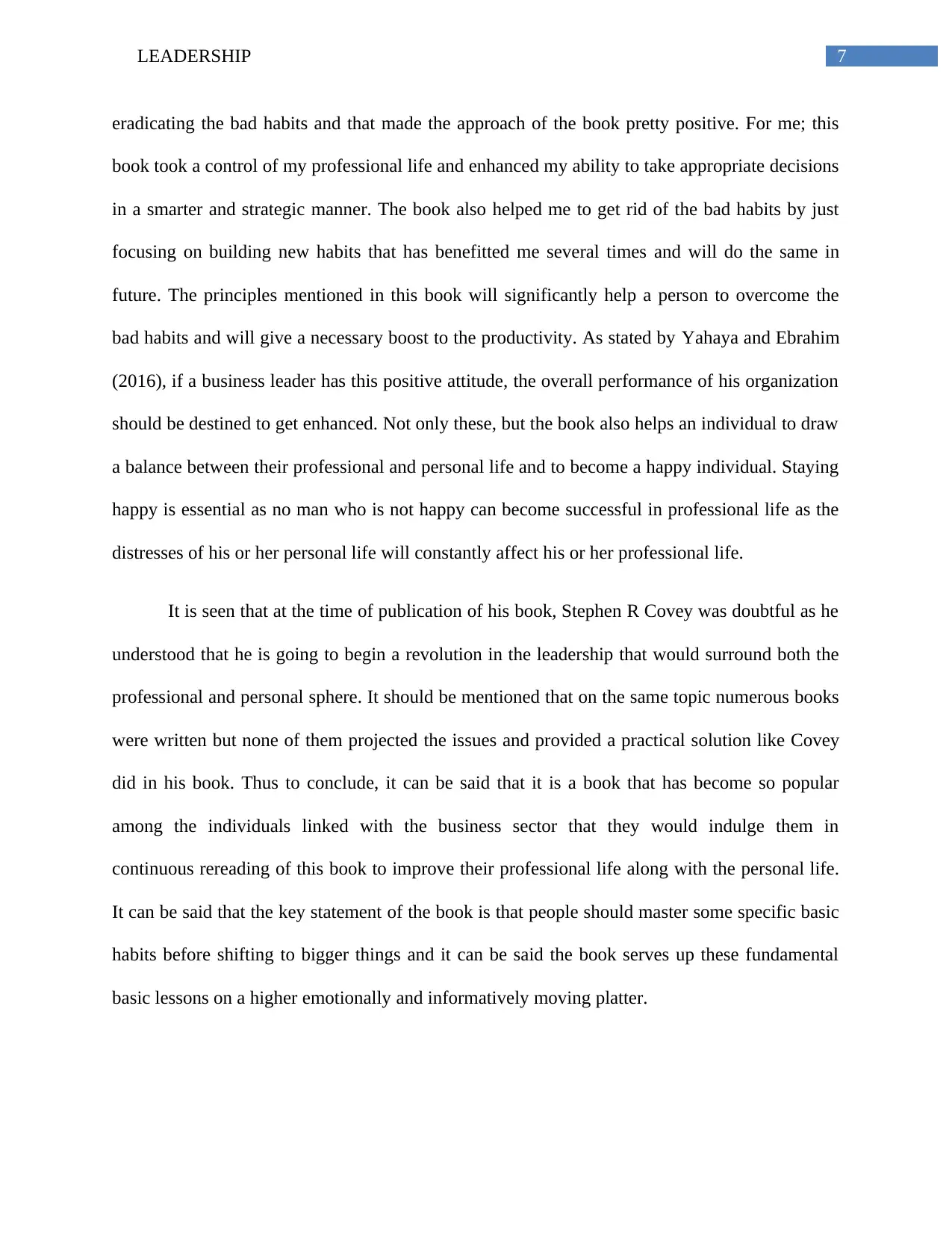
7LEADERSHIP
eradicating the bad habits and that made the approach of the book pretty positive. For me; this
book took a control of my professional life and enhanced my ability to take appropriate decisions
in a smarter and strategic manner. The book also helped me to get rid of the bad habits by just
focusing on building new habits that has benefitted me several times and will do the same in
future. The principles mentioned in this book will significantly help a person to overcome the
bad habits and will give a necessary boost to the productivity. As stated by Yahaya and Ebrahim
(2016), if a business leader has this positive attitude, the overall performance of his organization
should be destined to get enhanced. Not only these, but the book also helps an individual to draw
a balance between their professional and personal life and to become a happy individual. Staying
happy is essential as no man who is not happy can become successful in professional life as the
distresses of his or her personal life will constantly affect his or her professional life.
It is seen that at the time of publication of his book, Stephen R Covey was doubtful as he
understood that he is going to begin a revolution in the leadership that would surround both the
professional and personal sphere. It should be mentioned that on the same topic numerous books
were written but none of them projected the issues and provided a practical solution like Covey
did in his book. Thus to conclude, it can be said that it is a book that has become so popular
among the individuals linked with the business sector that they would indulge them in
continuous rereading of this book to improve their professional life along with the personal life.
It can be said that the key statement of the book is that people should master some specific basic
habits before shifting to bigger things and it can be said the book serves up these fundamental
basic lessons on a higher emotionally and informatively moving platter.
eradicating the bad habits and that made the approach of the book pretty positive. For me; this
book took a control of my professional life and enhanced my ability to take appropriate decisions
in a smarter and strategic manner. The book also helped me to get rid of the bad habits by just
focusing on building new habits that has benefitted me several times and will do the same in
future. The principles mentioned in this book will significantly help a person to overcome the
bad habits and will give a necessary boost to the productivity. As stated by Yahaya and Ebrahim
(2016), if a business leader has this positive attitude, the overall performance of his organization
should be destined to get enhanced. Not only these, but the book also helps an individual to draw
a balance between their professional and personal life and to become a happy individual. Staying
happy is essential as no man who is not happy can become successful in professional life as the
distresses of his or her personal life will constantly affect his or her professional life.
It is seen that at the time of publication of his book, Stephen R Covey was doubtful as he
understood that he is going to begin a revolution in the leadership that would surround both the
professional and personal sphere. It should be mentioned that on the same topic numerous books
were written but none of them projected the issues and provided a practical solution like Covey
did in his book. Thus to conclude, it can be said that it is a book that has become so popular
among the individuals linked with the business sector that they would indulge them in
continuous rereading of this book to improve their professional life along with the personal life.
It can be said that the key statement of the book is that people should master some specific basic
habits before shifting to bigger things and it can be said the book serves up these fundamental
basic lessons on a higher emotionally and informatively moving platter.
Paraphrase This Document
Need a fresh take? Get an instant paraphrase of this document with our AI Paraphraser
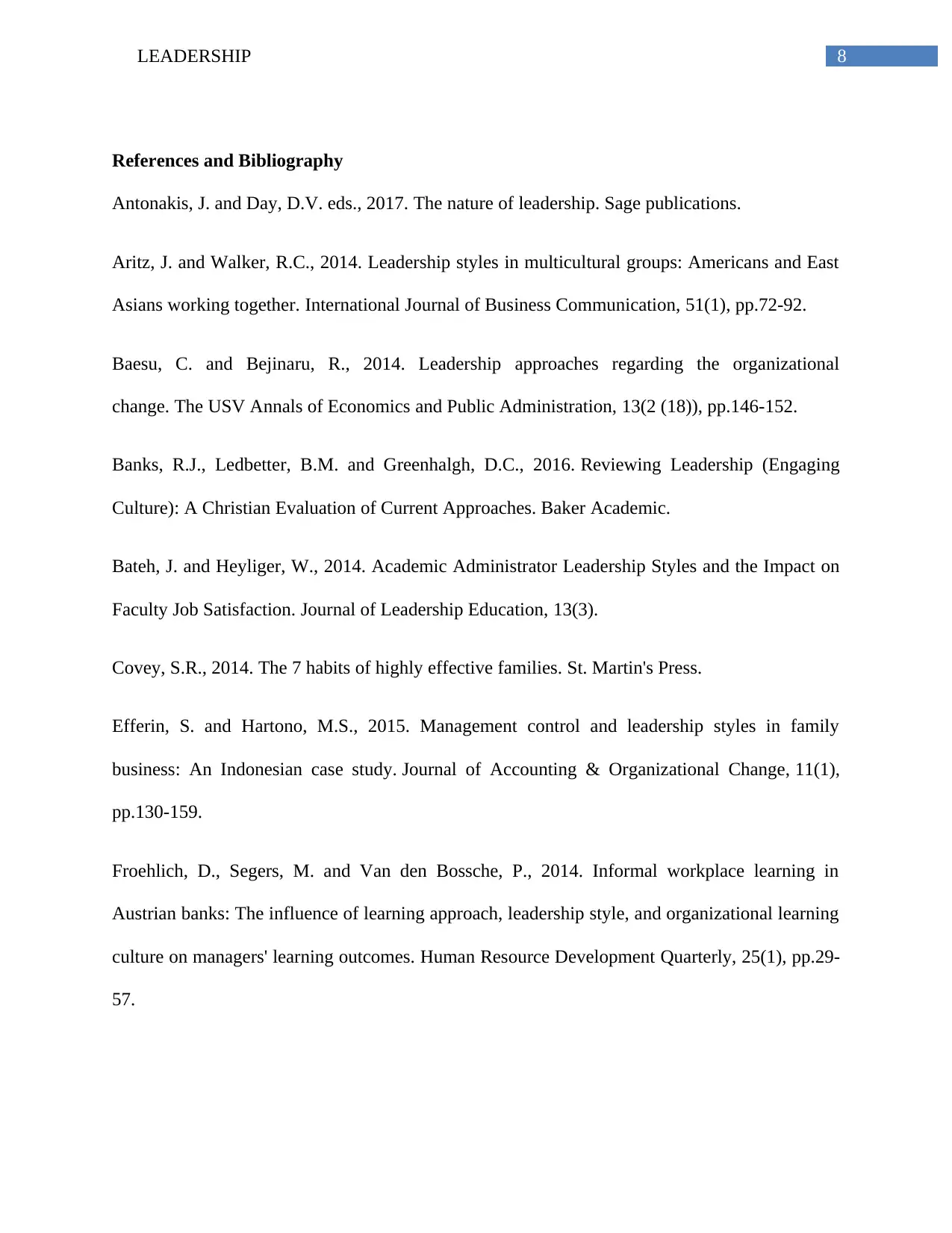
8LEADERSHIP
References and Bibliography
Antonakis, J. and Day, D.V. eds., 2017. The nature of leadership. Sage publications.
Aritz, J. and Walker, R.C., 2014. Leadership styles in multicultural groups: Americans and East
Asians working together. International Journal of Business Communication, 51(1), pp.72-92.
Baesu, C. and Bejinaru, R., 2014. Leadership approaches regarding the organizational
change. The USV Annals of Economics and Public Administration, 13(2 (18)), pp.146-152.
Banks, R.J., Ledbetter, B.M. and Greenhalgh, D.C., 2016. Reviewing Leadership (Engaging
Culture): A Christian Evaluation of Current Approaches. Baker Academic.
Bateh, J. and Heyliger, W., 2014. Academic Administrator Leadership Styles and the Impact on
Faculty Job Satisfaction. Journal of Leadership Education, 13(3).
Covey, S.R., 2014. The 7 habits of highly effective families. St. Martin's Press.
Efferin, S. and Hartono, M.S., 2015. Management control and leadership styles in family
business: An Indonesian case study. Journal of Accounting & Organizational Change, 11(1),
pp.130-159.
Froehlich, D., Segers, M. and Van den Bossche, P., 2014. Informal workplace learning in
Austrian banks: The influence of learning approach, leadership style, and organizational learning
culture on managers' learning outcomes. Human Resource Development Quarterly, 25(1), pp.29-
57.
References and Bibliography
Antonakis, J. and Day, D.V. eds., 2017. The nature of leadership. Sage publications.
Aritz, J. and Walker, R.C., 2014. Leadership styles in multicultural groups: Americans and East
Asians working together. International Journal of Business Communication, 51(1), pp.72-92.
Baesu, C. and Bejinaru, R., 2014. Leadership approaches regarding the organizational
change. The USV Annals of Economics and Public Administration, 13(2 (18)), pp.146-152.
Banks, R.J., Ledbetter, B.M. and Greenhalgh, D.C., 2016. Reviewing Leadership (Engaging
Culture): A Christian Evaluation of Current Approaches. Baker Academic.
Bateh, J. and Heyliger, W., 2014. Academic Administrator Leadership Styles and the Impact on
Faculty Job Satisfaction. Journal of Leadership Education, 13(3).
Covey, S.R., 2014. The 7 habits of highly effective families. St. Martin's Press.
Efferin, S. and Hartono, M.S., 2015. Management control and leadership styles in family
business: An Indonesian case study. Journal of Accounting & Organizational Change, 11(1),
pp.130-159.
Froehlich, D., Segers, M. and Van den Bossche, P., 2014. Informal workplace learning in
Austrian banks: The influence of learning approach, leadership style, and organizational learning
culture on managers' learning outcomes. Human Resource Development Quarterly, 25(1), pp.29-
57.
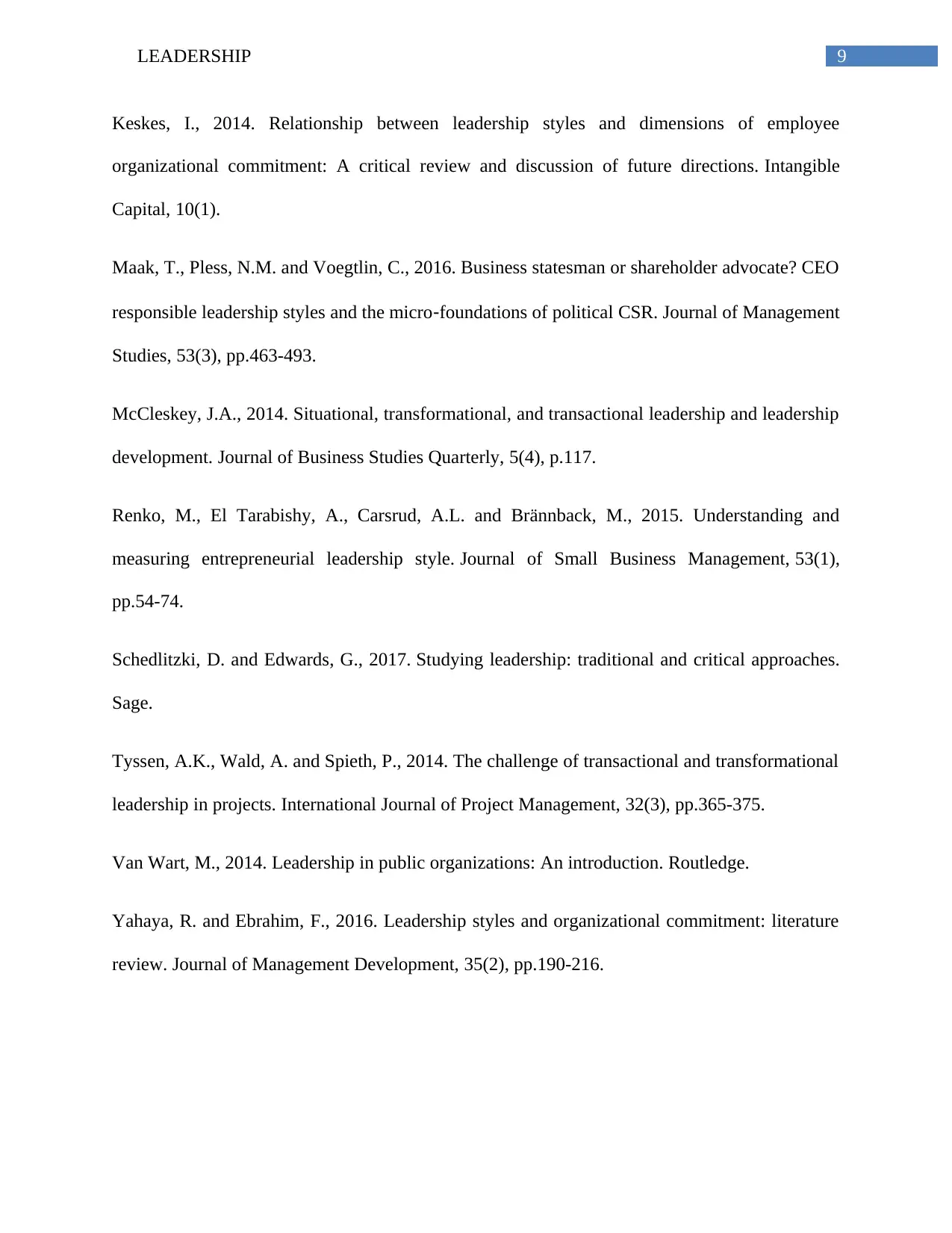
9LEADERSHIP
Keskes, I., 2014. Relationship between leadership styles and dimensions of employee
organizational commitment: A critical review and discussion of future directions. Intangible
Capital, 10(1).
Maak, T., Pless, N.M. and Voegtlin, C., 2016. Business statesman or shareholder advocate? CEO
responsible leadership styles and the micro‐foundations of political CSR. Journal of Management
Studies, 53(3), pp.463-493.
McCleskey, J.A., 2014. Situational, transformational, and transactional leadership and leadership
development. Journal of Business Studies Quarterly, 5(4), p.117.
Renko, M., El Tarabishy, A., Carsrud, A.L. and Brännback, M., 2015. Understanding and
measuring entrepreneurial leadership style. Journal of Small Business Management, 53(1),
pp.54-74.
Schedlitzki, D. and Edwards, G., 2017. Studying leadership: traditional and critical approaches.
Sage.
Tyssen, A.K., Wald, A. and Spieth, P., 2014. The challenge of transactional and transformational
leadership in projects. International Journal of Project Management, 32(3), pp.365-375.
Van Wart, M., 2014. Leadership in public organizations: An introduction. Routledge.
Yahaya, R. and Ebrahim, F., 2016. Leadership styles and organizational commitment: literature
review. Journal of Management Development, 35(2), pp.190-216.
Keskes, I., 2014. Relationship between leadership styles and dimensions of employee
organizational commitment: A critical review and discussion of future directions. Intangible
Capital, 10(1).
Maak, T., Pless, N.M. and Voegtlin, C., 2016. Business statesman or shareholder advocate? CEO
responsible leadership styles and the micro‐foundations of political CSR. Journal of Management
Studies, 53(3), pp.463-493.
McCleskey, J.A., 2014. Situational, transformational, and transactional leadership and leadership
development. Journal of Business Studies Quarterly, 5(4), p.117.
Renko, M., El Tarabishy, A., Carsrud, A.L. and Brännback, M., 2015. Understanding and
measuring entrepreneurial leadership style. Journal of Small Business Management, 53(1),
pp.54-74.
Schedlitzki, D. and Edwards, G., 2017. Studying leadership: traditional and critical approaches.
Sage.
Tyssen, A.K., Wald, A. and Spieth, P., 2014. The challenge of transactional and transformational
leadership in projects. International Journal of Project Management, 32(3), pp.365-375.
Van Wart, M., 2014. Leadership in public organizations: An introduction. Routledge.
Yahaya, R. and Ebrahim, F., 2016. Leadership styles and organizational commitment: literature
review. Journal of Management Development, 35(2), pp.190-216.
⊘ This is a preview!⊘
Do you want full access?
Subscribe today to unlock all pages.

Trusted by 1+ million students worldwide
1 out of 9
Your All-in-One AI-Powered Toolkit for Academic Success.
+13062052269
info@desklib.com
Available 24*7 on WhatsApp / Email
![[object Object]](/_next/static/media/star-bottom.7253800d.svg)
Unlock your academic potential
Copyright © 2020–2025 A2Z Services. All Rights Reserved. Developed and managed by ZUCOL.
